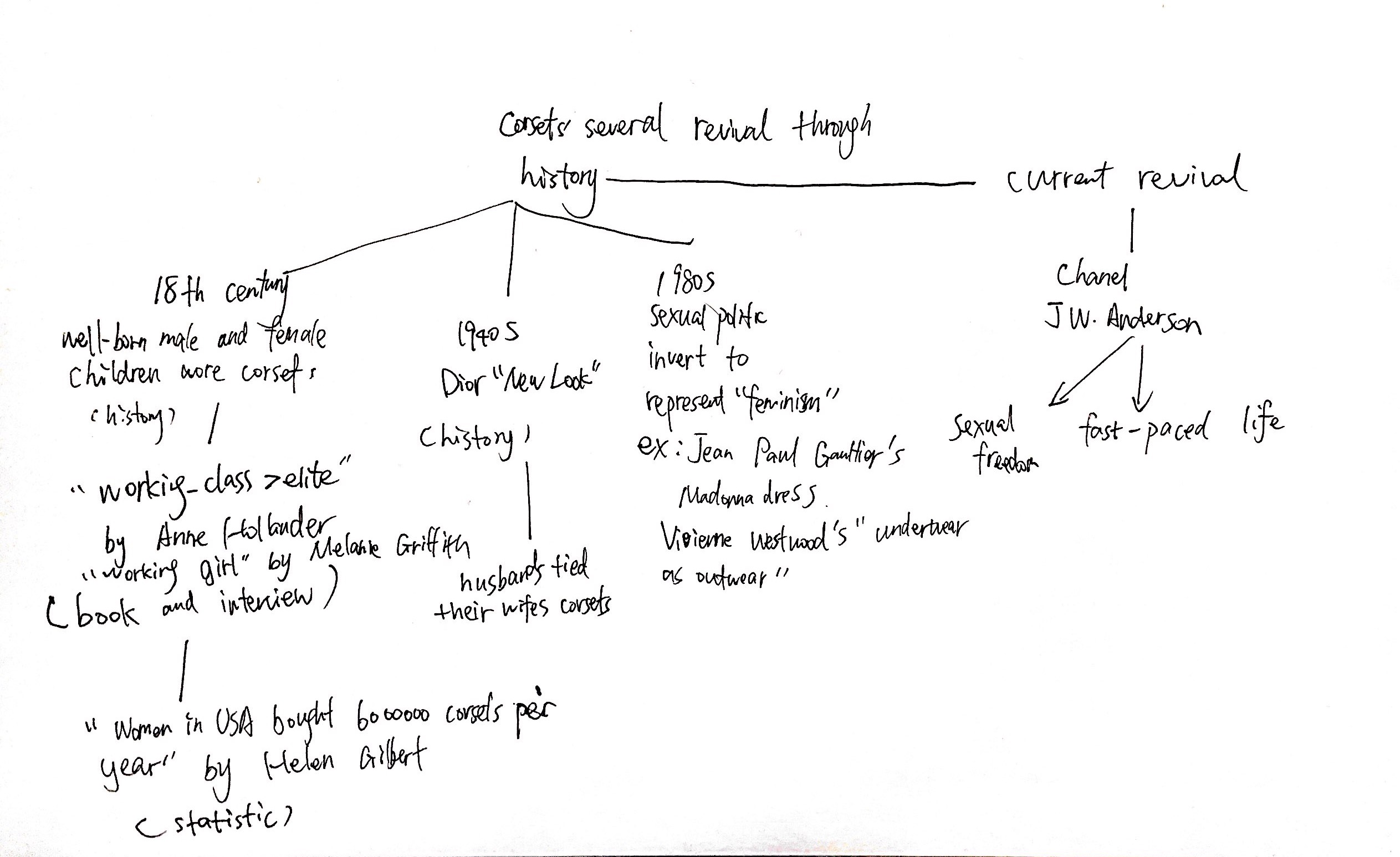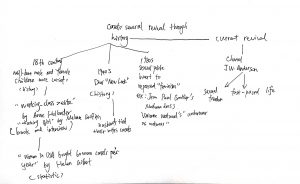Close reading
(the material this week I chose was a video, so I used the article from last week’s reading reflection)
https://www.nytimes.com/2016/11/25/t-magazine/fashion/corset-history-feminism.html
Can a Corset Be Feminist?
1.Write down all the words that are central to the article. Looking at the words, extract the main themes the article touches on.
Words:
corset, restriction, femininity, masculine, sexuality, feminist, sexual politics, working-class, reshape, subservience, empowerment
Main theme:
How corsets, the symbol of restriction and femininity, become the symbol of feminist and independency today.
2.What research questions do you think the author asked before beginning work on this article?
What is the turning point of the wearing of corsets? Who or what caused that resurgence? Who wore corsets the most in past? Were the working-class or the eliot? What are the most relative piece on the runway or in fashion world? What’s the connection between today’s resurgence of corsets with the current situation of society?
3.What is the thesis of the article? (What is the main idea the author wants to convey? *It should hopefully be an answer to one of the questions above.
The corsets in the past were the embodiment of the aesthetic ideal of male towards female, the productions of patriarchal society. The wearing of corsets today represents sexual freedom and girl’s power, also relates to today’s society of fast food culture which seek for dramatic change in a quick time. Corsets are the attire that can reshape the body silhouette directly.
4. Research the author/publication of the piece. What do you think is the agenda of the article? What does it want to reader to take away from the piece?
Alexander Fury is a fashion journalist, author and critic. He was the inaugural Men’s Critic for American Vogue.com, covering the Winter 2016 and Spring 2017 menswear seasons. Fury was the first journalist to receive the Editorial Intelligence Award for Fashion Commentator of the Year 2014-15, and was named one of InStyle magazine’s 20 most powerful people in fashion in 2015. He is a member of the Business of Fashion’s BoF 500. His first book Dior: Catwalk was published by Thames and Hudson in June 2017; a second, Catwalking, charting the career of catwalk photographer Chris Moore, was released in November 2017.
And I found out that he had interviewed with diverse artists and designers such as lady gaga, Martin Margiela.
Publication:
T: The New York Times Style Magazine
T: The New York Times Style Magazine is a perfect-bound magazine dedicated to fashion, living, beauty, holiday, travel and design coverage. The magazine was launched in August 2004. Since January 2017, it has been scheduled to publish 11 times a year
link of this magazine:
the agenda of the article:
I think the agenda of this article is tried to remind women how to examine themselves from their own, not from the eyes of male. It is an encouragement of breaking gender restrictions and staying true to themselves.
5. Underline all the information that needed to be researched. Create a mind map of all the different sources the author used.
“In the 20th century, the corset experienced two great and lasting revivals, in the 1940s and in the 1980s. These were two opposing ends. The first was Christian Dior’s “New Look” of 1947, an ironic moniker given that the silhouette requisitioned the corsetry that had been shrugged off by women back in the Edwardian era. Dior’s corsets were of lighter construction, but their nickname, “waspies,” underlined their goal to pinch women’s waists to wasplike insignificance.What Dior built was a resolute conservative view of femininity, and although fashion history has it that women fell into Dior’s silhouettes with gay abandon, the reality was more torn. In America, a group of women formed the Little Below the Knee Club to protest Dior’s cumbersome skirts (some included 130 feet of fabric).”
“by the fact that in 1675, Louis XIV incorporated a guild of female dressmakers to make all clothes for women, except for riding habits and corsets, which were to be made only by men. While the former was an almost-unique symbol of female freedom of pursuit (nearly 100 years later, the much-beleaguered Marie Antoinette even rode in breeches, in an attempt to wrench herself free of the restrictions of life as queen consort at the French court), the latter came to epitomize the male hold on women, figuratively as well as literally.”
“In the 18th century, well-born male and female children alike were laced into stays (boned bodices, the antecedent of the corset) — boys until the age of 6. Boned stays were sewn into men’s coats during the same period to stiffen and support before the rise of tailoring. And up until the 1950s, it wasn’t uncommon for men to wear “body belts,” helping form a trim silhouette, albeit secretly. Male corsets were hidden, viewed as deeply suspect by conservative 19th-century society, while simultaneously women’s corsets were considered a moral requirement, a necessary layer in decent society.”
“In 1989, Jean Paul Gaultier famously dressed Madonna in a pink satin corset with conical-stitched breasts, resembling the “waspie” foundation garments of Dior’s time; but Vivienne Westwood came before. Westwood’s collaborator, the late Malcolm McLaren, coined the phrase “underwear as outerwear” to describe a quilted satin brassiere worn on the outside of a sweatshirt in their 1982-83 Buffalo Girls (Nostalgia of Mud) collection; five years later, Westwood proposed elastic-sided variants on 18th-century-style stays, squared off at the cleavage below a balcony of heaving chest.”
“in 1892, when the dress reformer Helen Gilbert Ecob claimed that American women bought 60,000,000 corsets per year.”
“Back in the 19th century, satire had it that husbands were frequently called upon to lace their wives into their corsets: on the one hand because the strength required exceeded that of a ladies’ maid, but also so that men could see if the laces had been untied and refastened incorrectly by a lover.”
Mindmap:
6. Define 5-10 unfamiliar words.
reclamation: reformation, the process of claiming something back or of reasserting a right
inversion: a reversal, the action of inverting something or the state of being inverted
emancipation: to free from restraint, slavery
encapsulate: (v.) put in a short or concise form, to sum it up
malleable: easily influenced or changed / can easily be made into different shapes
resurgence: (n.) the revival, the return of an activity that had stopped


